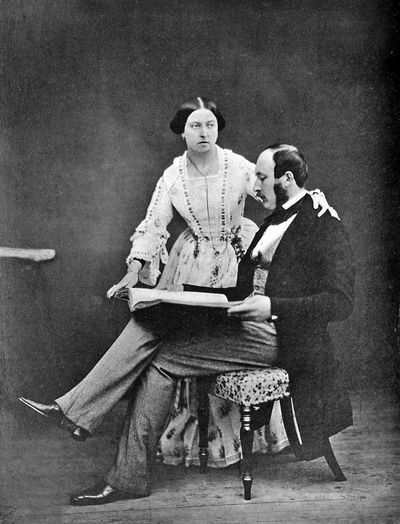Annotation:Prince Albert's Hornpipe (1): Difference between revisions
No edit summary |
m (Text replacement - "garamond, serif" to "sans-serif") |
||
| Line 1: | Line 1: | ||
=='''Back to [[{{BASEPAGENAME}}]]'''== | =='''Back to [[{{BASEPAGENAME}}]]'''== | ||
---- | ---- | ||
<p><font face=" | <p><font face="sans-serif" size="4"> | ||
'''PRINCE ALBERT HORNPIPE [1].''' AKA and see “[[Newcastle Clog]],” “[[Newcastle Hornpipe (1) (The)]].” English, Hornpipe. B Flat Major. Standard tuning (fiddle). AABB. The melody is attributed to the 19th century Tyneside fiddler and composer James Hill (d. 1853), in the first volume of '''Kohler’s Violin Repository''' (Edinburgh, 1881). It may be that Hill composed it on the occasion of Queen Victoria and Prince Albert's appearance at the official opening of the High Level Bridge and the Central Station in Newcastle on August 29th, 1850. | '''PRINCE ALBERT HORNPIPE [1].''' AKA and see “[[Newcastle Clog]],” “[[Newcastle Hornpipe (1) (The)]].” English, Hornpipe. B Flat Major. Standard tuning (fiddle). AABB. The melody is attributed to the 19th century Tyneside fiddler and composer James Hill (d. 1853), in the first volume of '''Kohler’s Violin Repository''' (Edinburgh, 1881). It may be that Hill composed it on the occasion of Queen Victoria and Prince Albert's appearance at the official opening of the High Level Bridge and the Central Station in Newcastle on August 29th, 1850. | ||
[[File:Queen_Victoria_and_Prince_Albert_1854.jpg|400px|thumb|left|Queen Victoria and Prince Albert in 1854.]] | [[File:Queen_Victoria_and_Prince_Albert_1854.jpg|400px|thumb|left|Queen Victoria and Prince Albert in 1854.]] | ||
| Line 10: | Line 10: | ||
<br> | <br> | ||
</font></p> | </font></p> | ||
<p><font face=" | <p><font face="sans-serif" size="4"> | ||
''Source for notated version'': | ''Source for notated version'': | ||
<br> | <br> | ||
<br> | <br> | ||
</font></p> | </font></p> | ||
<p><font face=" | <p><font face="sans-serif" size="4"> | ||
''Printed sources'': Honeyman ('''Strathspey, Reel and Hornpipe Tutor'''), 1898; p. 52. Laybourn ('''Köhler’s Violin Repository, Book One'''), 1881; p. 86. | ''Printed sources'': Honeyman ('''Strathspey, Reel and Hornpipe Tutor'''), 1898; p. 52. Laybourn ('''Köhler’s Violin Repository, Book One'''), 1881; p. 86. | ||
<br> | <br> | ||
<br> | <br> | ||
</font></p> | </font></p> | ||
<p><font face=" | <p><font face="sans-serif" size="4"> | ||
''Recorded sources'': <font color=teal></font> | ''Recorded sources'': <font color=teal></font> | ||
<br> | <br> | ||
<br> | <br> | ||
</font></p> | </font></p> | ||
<p><font face=" | <p><font face="sans-serif" size="4"> | ||
See also listing at:<Br> | See also listing at:<Br> | ||
Alan Snyder’s Cape Breton Fiddle Recordings Index [http://www.cbfiddle.com/rx/tune/t161.html]<br> | Alan Snyder’s Cape Breton Fiddle Recordings Index [http://www.cbfiddle.com/rx/tune/t161.html]<br> | ||
Revision as of 15:36, 6 May 2019
Back to Prince Albert's Hornpipe (1)
PRINCE ALBERT HORNPIPE [1]. AKA and see “Newcastle Clog,” “Newcastle Hornpipe (1) (The).” English, Hornpipe. B Flat Major. Standard tuning (fiddle). AABB. The melody is attributed to the 19th century Tyneside fiddler and composer James Hill (d. 1853), in the first volume of Kohler’s Violin Repository (Edinburgh, 1881). It may be that Hill composed it on the occasion of Queen Victoria and Prince Albert's appearance at the official opening of the High Level Bridge and the Central Station in Newcastle on August 29th, 1850.

Source for notated version:
Printed sources: Honeyman (Strathspey, Reel and Hornpipe Tutor), 1898; p. 52. Laybourn (Köhler’s Violin Repository, Book One), 1881; p. 86.
Recorded sources:
See also listing at:
Alan Snyder’s Cape Breton Fiddle Recordings Index [1]
